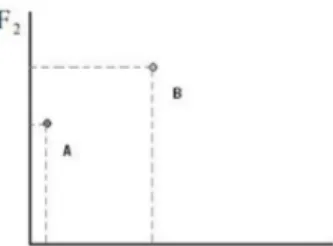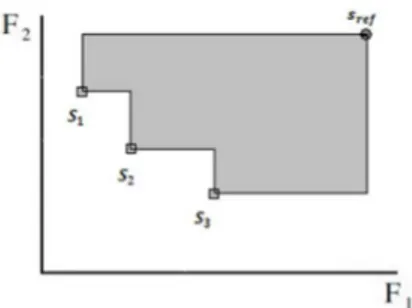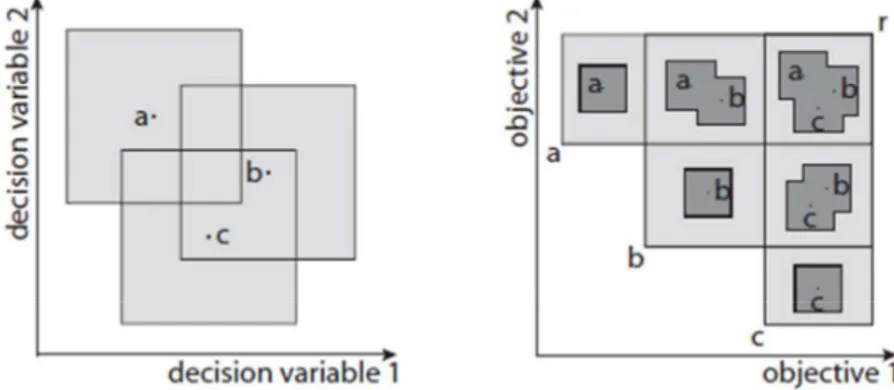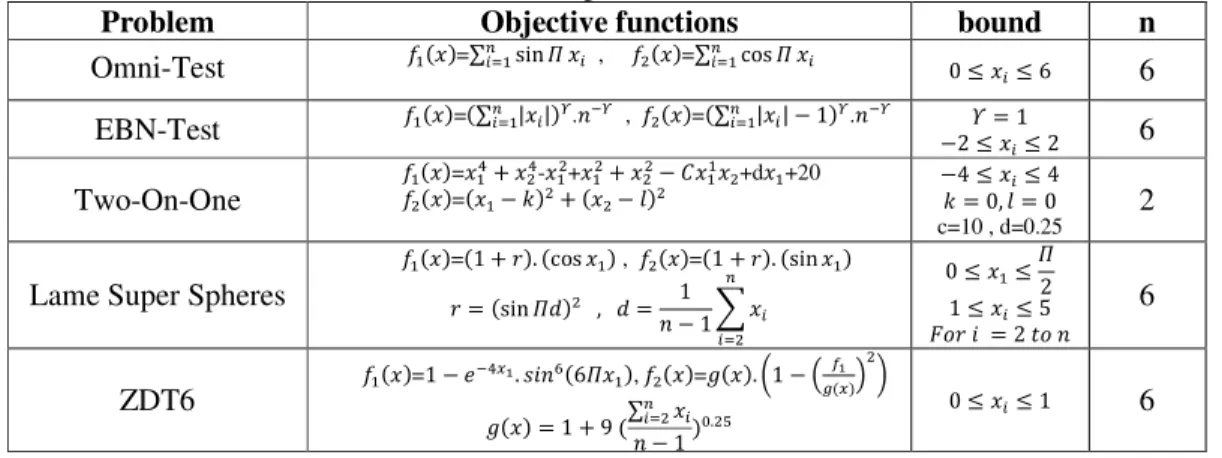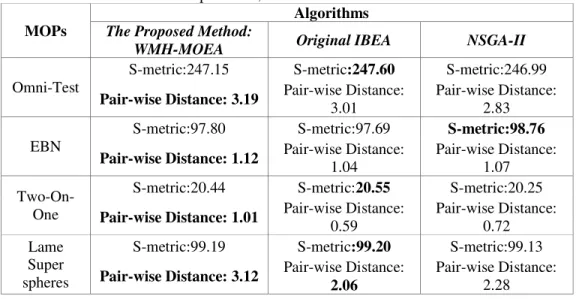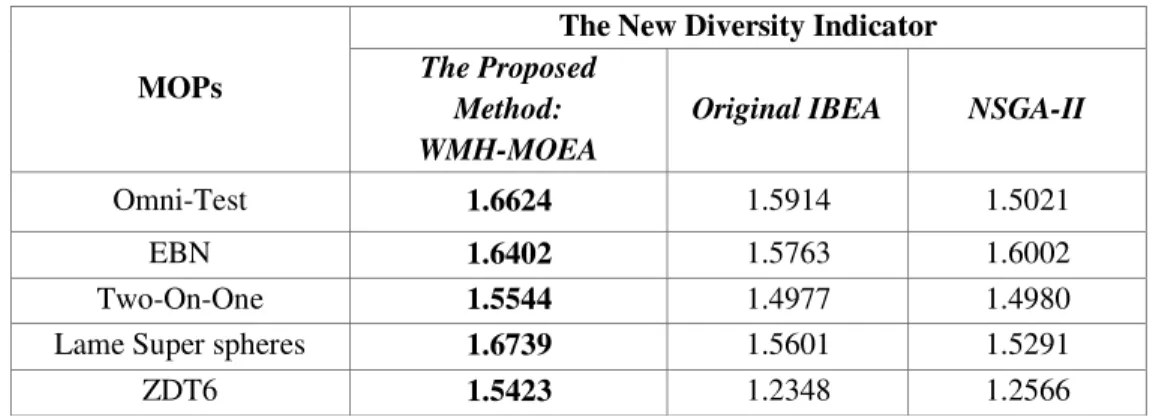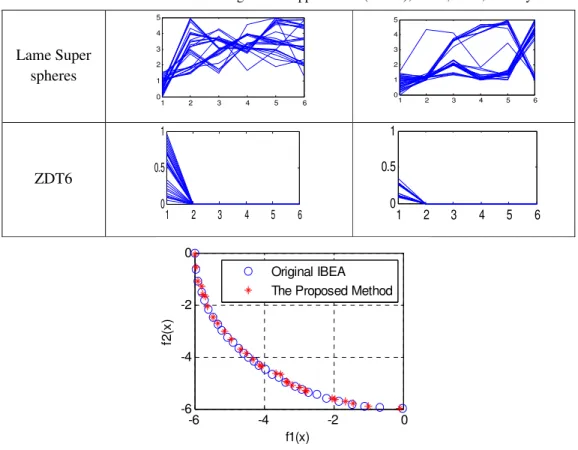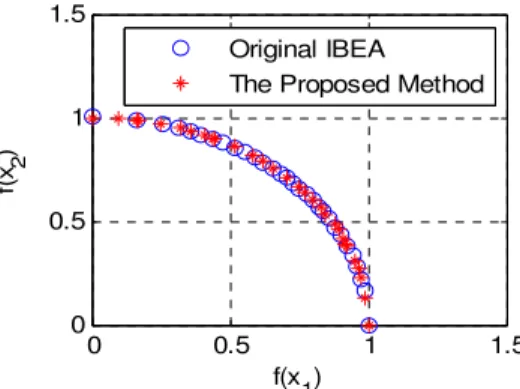DOI : 10.5121/ijaia.2012.3106 65
Kamyab Tahernezhadiani, Ali Hamzeh and Sattar Hashemi
Department of Computer Science Engineering and Information Technology, Shiraz University, Shiraz, Iran
tahernezhadiani@cse.shirazu.ac.ir
ali@cse.shirazu.ac.ir
s.hashemi@shirazu.ac.ir
A
BSTRACTDiversity is an important notion in multi-objective evolutionary algorithms (MOEAs) and a lot of researchers have investigated this issue by means of appropriate methods. However most of evolutionary multi-objective algorithms have attempted to take control on diversity in the objective space only and maximized diversity of solutions (population) on Pareto- front. Nowadays due to importance of Multi-objective optimization in industry and engineering, most of the designers want to find a diverse set of Pareto-optimal solutions which cover as much as space in its feasible regain of the solution space. This paper addresses this issue and attempt to introduce a method for preserving diversity of non-dominated solution (i.e. Pareto-set) in the solution space. This paper introduces the novel diversity measure as a first time, and then this new diversity measure is integrated efficiently into the hypervolume based Multi-objective method. At end of this paper we compare the proposed method with other state-of-the-art algorithms on well-established test problems. Experimental results show that the proposed method outperforms its competitive MOEAs respect to the quality of solution space criteria and Pareto-set approximation.
K
EYWORDSMulti-objective optimization, Evolutionary algorithm, Diversity, Pareto-set and Hypervolume.
1.
I
NTRODUCTION66 In the literature, all non-dominated solutions in the objective space are called Pareto-front and all non-dominated solutions in the solution space are called Pareto-set [1]. Aims of any elocutionary based multi-objective optimizations are converging to the true Pareto-front and providing diversity of non-dominated solutions in objective and/or solution space. Most MOEAs have concentrated on diversity in the objective space only and less have attempted to enhance diversity in terms of the solution space. Therefore outcomes of existing MOEAs have enough diverse Pareto-front to satisfy designer, meanwhile population diversity of their Pareto-set is not desirable. For example, in NSGA-II as one of the state of the art MOEAs proposed by Deb et al. [3], solutions in the highest rank in sorting algorithm, only one of them survives, if it has a more distance from its neighbors in the objective space, SMS-MOEA [4] for other instance, aiming at maximizing the hypervolume indicator of obtained non-dominated solutions in the objective space. Many other methods are presented in [1] dealing with MOPs purposefully. All of which except NSGA [5], optimize indicators which compatible with Pareto-front only. In NSGA, Researchers used a niching approach for maintaining diversity of solutions in the solution space then adopted the non-dominated sorting algorithm to guide the search to the optimal solutions.
In single-objective optimization usually term of diversity referred to solution (i.e. genotype) space diversity. In such problems diversity takes an important role to obtain better results and prevents to premature convergence [6], however in multi-objective problems this issue already exists and enhancing diversity of solution space help to seek from local outcomes. Few years ago, some studies have picked up on diversity of Pareto-set as an objective in Multi-objective based methods [7-10]. But those studies are very few and because of the importance of this issue, it is a necessity to develop and introduce new approaches.
In this paper, we provide and introduce a new mechanism based on Indicator-based MOEA (i.e. SMS-EMOA [4]). Recently hypervolume-based evolutionary multi-objective algorithms have tackled by most of researchers and become suitable approaches due to their outstanding potential capabilities for fulfilling user preferences that are compliant with principle of Pareto optimality [11-12]. In those frameworks, solutions are survived and being as a parent based on their contributions respect to hypervolume [13]. The main motivation behind to this paper is acquiring set of non-dominated solutions as diverse as in the solution space. For do that, in environmental selection phase of evolutionary framework, solutions have been survived if be able to optimize both diversity and Pareto optimality indicators. In this study because of attainment to the main aim of this paper (i.e. enhancing population diversity in the Pareto- optimal set), we have adjusted parameter values and also modified some parts of algorithms proposed in [4]. In fact, we have weighted all marginal parts of generated hypervolume in the objective space by appropriate diversity indicator values of non-dominated solutions in the solution space. Our proposed method so called, weighted marginal hypervolume-multi-objective evolutionary algorithm: (WMH-MOEA) capable to obtain a set of non-dominated solutions that has a good hypervolume measure as a criterion in the objective space having a good diversity indicator as a performance measure in the solution space. Actually, our innovation is embedding the novel diversity indicator in the solution space into hypervolume criterion in the objective space.
67
2.
BACKGROUND
In this section we describe some fundamental concepts of evolutionary multi-objective algorithm in more detail.
2.1. Multi-objective Optimization
Without loss of generality; an -objective minimization problem is described as follows:
(1)
where is the -dimensional objective vector, is the -th objective to be minimized. is
the decision vectors belong to feasible region of solution space.
2.2. Pareto Optimality
Let and be two feasible solutions of the -objective minimization problem in (Equation 1). If
the following conditions hold, can be viewed as being better than and say dominates or
is dominated by .
! " # $ % &' () * ! + * # , - . / 0 ! 1 0 # (2)
Figure 1 shows a graphical illustration of (Equation 2). When is not dominated by any other feasible solutions, we say that, is a non-dominated solution. Set of all non-dominated solutions in decision space, called Pareto (-optimal) set and set of all non-dominated solution in objective space, called Pareto (-optimal) front, mathematically described as follows:
2 3 & 45 6 7 6" ( (3)
2 3 & 4 8 2 } (4)
Figure 1. Graphical illustration of dominance relation 2.3. Hypervolume
68
96: ;<=>? @ ABCD EFGHI JAM K4A " AK" ABCDLN (5)
where OPQ denotes the Lebesgue measure and RSTU denotes the reference point. Figure 1 shows the hypervolume of a non-dominated set as a gray region.
Figure 2. Hypervolume of non-dominated solutions
Fleischer [14] prove that the hypervolume indicator attains its maximum if and only if its non-dominated vectors in the objective space equals to its true Pareto-front. Also a set of bounded size which has reached to its maximal hypervolume value should be well-distributed on its true Pareto-front [13]. Respect to a lot of advantages, this measure has one downside which is the computational complexity. It is shown that the exact calculation of the hypervolume is classified in NP-Hard problems [15]. But its drawback could be solved by means of approximation methods and estimative approaches [16].
2.4. Basic MOEAs
In the following we will briefly explain some well-known researches in contest of evolutionary multi objective algorithms. As the most popular method, “Nondominated Sorting Genetic Algorithm” NSGA-II proposed by Deb et al. [3], using an elite survival selection mechanism with fast non-dominated sorting algorithm for classification of candidate solutions into domination ranks. NSGA-II adopts crowding distance mechanism for diversity preservation in the Pareto-front. In this approach, solutions which belong to the lower (i.e. better) rank and be farther from its neighbors has higher probability to become as a parent and will survive (i.e. assigned higher fitness value). Figure 3 shows the environmental selection in NSGA-II.
69 Figure 3. Graphical illustration of crowding distance in NSGA-II [3]
V WX Y V WX&A( , WX &A4A higher level( (6)
Figure 4. Graphical representation of marginal hypervolume of final non-dominated ranked solutions in environmental selection of SMS-EMOA, for example in this figure the solution is the best candidate for elimination.
3.
RELATED
WORK
Maintaining population diversity in the solution space recently is one of the important research topics in terms of multi-objective evolutionary algorithms not only because of its advantages but also because there are many open questions in its realm. Several researches have denoted and illustrated some characteristic of new test problems related to diversity of the Pareto-set and compared diversity indicator of non-dominated solutions of existing MOEAs [9, 17].In GDEA proposed by Toffolo and Benini [18] invoked two selection mechanism, nondominated sorting approach from Goldberg [19] as the primary one for ranking and a distance-based measure for preserving diversity of obtained non-dominated set in the solution space. Another approach proposed by Deb and Tiwari [7] in which integrated the crowding distance in the solution space into the nondominated sorting scheme and extended the framework of NSGA-II consequently, make better diversity criterion in the solution space. Shir et al. [8] also proposed in which integrated two set criteria into CMA-ES niching framework to promote solution space diversity. MMEA [9] another new approach, has used a probabilistic model-based multi-objective evolutionary algorithm. In this method, at first, the population is clustered into a number of subpopulations, the principal component analysis (i.e. PCA) approach is used to estimate the dimensionality of the Pareto-set diversity in each subpopulation, and then a probabilistic model of non-dominated solution is built. After this, new offspring is generated based on this model. Diversity preserving in this method is regarded to genetic operators and take advantage of estimation of distribution algorithm (EDA) mechanism.
70 proposed by Zitzler et al. [10] in more detail. In DIVA first, diversity of non-dominated solution is calculated respect to the solution space. Then hypervolume of outstanding solutions is computed in the objective space and partitioned in appropriate segments. Each segment of the divided hypervolume is weighted and modified based on diversity indicator values of relevant solutions. Figure 5 shows the mechanism of integration in DIVA. The Rest of this method is similar to other indicator-based evolutionary multi-objective algorithms. By integrating the diversity indicator of non-dominated solutions corresponding to the solution space into hypervolume measure, the search algorithm is encouraged to find more diverse Pareto-set.
Figure 5. The left figure shows the three solutions in the solution (decision) space with their diversity measure. The right figure shows the hypervolume partitions, where in each partition the relevant diversity is shown qualitatively. This figure is taken from DIVA [10]
According to DIVA, it seems that some contributions make to be better quality of diversity indicator and in addition, modifying the selection mechanism can help to the algorithm for saving time-consumption. In this study a novel diversity indicator is introduced which released from the shape of coverage area and have not any extra parameters relative to DIVA.
4.
THE
PROPOSED
METHOD
Before discussing on our method, first we introduce the proposed diversity measure used in this paper and its properties are determined. In addition, all of conditions of any diversity set measures suggested in [20] are elucidated. Then we exhibit how such a diversity measure can be integrated into the hypervolume measure.
71 Figure 6. Comparison of traditional diversity indicator (i.e. average pair-wise distance) between two different sets. Although elements of the bottom shape are more divers then the above shape, but assigned lower diversity indicator (e.g. Z [3\] 3 ] ^
[ ')
In this paper we introduce the novel diversity mechanism as a first time for estimate dimensionality of non-dominated solutions in the solution space. Moreover this diversity masseur aims at solving the major drawback of pier-wise distance based diversity indicator. Our proposed diversity measure is based on pair-wise distance with some modifications. To calculate the diversity indicator of one set, at first place we compute the geometrical mean value of the set, then elements which far from the mean value are found. Now a circle is drawn around the mean value with specific radii (i.e. radii is computed based on Euclidean distance between the center and the extreme element). As soon as compute the radii, all of elements that hold on the circle or too close to the circle must be eliminate from the set after then the mean value of the modified set is updated and all parameters of generated circle are recalculated. This procedure continued until no element exists in the set. After termination, we sum all radiuses up and proposed this value as a diversity indicator of the set. Figure 7 illustrates the computing of the new diversity measure. In fact, all of which process is performed in solution (feature) space due to indicate how obtained Pareto-set is separable and diverse. The new diversity indicator is evaluated based on sum of sum of these radii and number of generated circle.
72 That parameter which determines how many of elements are close to circle is crucial and need to be optimized. This parameter plays a role of niching towards procedure of this diversity measure and do not allow number of elements are crowded in specific region, it means that this diversity indicator resolves downside of pair-wise distance indicator, furthermore using sequences of radii makes the set become enlarged. Finally the parameter which indicates number of center is utilized for separability of the set. With integrated all of generated parameters into a unit formula we can see that all of primary conditions of any diversity indicator discussed in [20] will be satisfied.
For getting better result we used a monotonic logarithmic function to adjust obtained value of diversity indicator. Equation (6) shows this function.
:;=:=A -_ < ;A @6 ` - a,@=; log '00 3 ' + C + hRlog '00 7
73 Figure 8. Block Diagram of proposed method
Step 1: Initialization
Step 2: Parent Selection (Random)
Step 4: Evaluate and Ranked all parents and Offspring based On Nondominated
sorting
Step 5: The Environmental Selection Step 3: Generate Offspring
with Recombination Operators (SBX and PM)
While (Number of all Candidate solutions is Higher than Initial one
Step 6: Find all Solutions Belong to the Latest (worst) rank in Nondominated Sorting Algorithm and indicated with X
Step 7: Weighted Marginal
Hypervolume Procedure (X)
Step 8: Eliminate relevant Solution respect to minimal
fitness assigned.
Compute the Marginal Hypervolume of Set (X) likes in SMS-EMOA [4]
Calculate the proposed Diversity Indicator of Set (X) in the solution
Weighting all parts of marginal hypervoume with its Diversity fitness Step 9: Until Stop
74 Another novelty of this paper is fitness assignment strategy in the environmental selection. As soon as marginal hypervolume is computed (i.e. hypervolume contribution regarding loss of relevant solution in the objective space), the diversity measure of each solution is calculated (i.e. regarding the losing relevant solution from Pareto-set in the solution space) and then two indicators are embedded. So worst members form below average population are removed in environmental selection. Figure 9 shows the embedding of diversity indicator to the hypervolume criterion.
Figure 9: fitness assignment in proposed method. In this case, k is denoted as a diversity indicator
5.
THE
EXPERIMENTAL
RESULT
This section is devoted to the evaluation of proposed method (WMH-MOEA) in both objective and solution space. For that, we have chosen several test problems taken from the specialized literature in order to assess how competitive WMH-MOEA is, we decided to compare it against two algorithms that are representative of the state-of-the- art, namely SMS-EMOA and NSGA-II.
5.1 Test Problems
All of test problems which have been adopted in this paper are continues bi-objective minimization problems [23-26]. None of them have any inequality or equality constraints. Also they belong to type 1 of test problems corresponding to the classification of test suite in [9].Table 1 shows all used test sites and their properties.
Table 1. Test problems used in this paper, n is the number of decision variables of the solution space
Problem Objective functions bound n
Omni-Test =l R mno*p * , =l qoR no*p * 0 + *+ r 6
EBN-Test =l 4o*p *4s. ts , =l 4o*p *4Y 's. ts u '
Yv + *+ v 6
Two-On-One
= w+ w- + + Y x +d +20
= Y y + Y > Yz +y 0 > 0*+ z
c=10 , d=0.25 2
Lame Super Spheres
=' + ; qoR , =' + ; R m
; R m n- - 'Y ' { *
o
*p
0 + +nv ' + *+ |
=; v @=
6
ZDT6 =' Y
tw}~A [rn , =• €' Y •D~
‚ }ƒ „
• ' + … lo*p *
Y ' Z †
75 5.2 Parameter Settings
In the following we explain parameter settings of methods that must be compared. Proposed method was run on test suite whit population size as well as the number of offspring was set to 30 and reference vector is 10 for computing the S-metric. Variation operators are SBX [27] and polynomial mutation [28] which are similar to NSGA-II [3]. Our algorithm was run for 500 generations. The NSGA-II algorithm was proposed by Deb et al. It is characterized by a Pareto ranking of the individuals and the use of a crowding distance as density estimator. Specifically, we used the real-coded version of the algorithm and the parameter settings proposed in [3]. The operators for recombination and mutation are SBX and polynomial mutation, with distribution indexes of q = 20 and = 20, respectively. A recombination probability of Pˆ = 0.9 and a mutation probability pŠ = 0.1 are used. The population size is 30 individuals. The algorithm stops after 500 generation. Another method that used for comparing with proposed method is SMS-EMOA. We adjust the model of steady state in this method to (µ+µ)-EA for decency between algorithms and in the following have addressed as the modified version of SMS-EMOA to Original IBEA.
5.3 Performance Metrics
To exploit the advantage of proposed method we used the S-metric as a measure to convergence of Pareto-front. In order to assess the enhancing of diversity in the decision space we calculated the average distances between solutions belongs to Pareto-set. Hypervolume or S-metric is a compliant measure related to Pareto dominance and computes the volume of the dominated region, demarcated by a given set of points (i.e. non-dominated solutions in objective space), and a reference vector. Higher value of this measure indicates that better performance corresponds to the objective space criteria and it means that the set of non-dominated solutions approximates close to the true Pareto-front.
Also we look at a commonly used diversity indicator to verify our findings in terms of population diversity in the solution space, so called pair-wise distance. Pair-wise distance computes the mean of all distances between members of Pareto-set in the solution space. Mathematically definition of pair-wise distance is:
Pair-wise Distance l l ‹Œ• Ž ••Œ ‘ ’•~
o ot / (8)
where ” is the distance between -th and j-th solution in the solution space. It is clear that if j
then ” must be equal to zero. Furthermore we use the proposed diversity indicator described in
past section (Equation. 6) to better demonstrate of capability of MOEAs corresponds to diversity of Pareto-set in the solution space.
The New Diversity Indicator =:;=:=A -_ < ;A @6 ` - a,@=;(Pareto-Set) (9)
5.4 The Experimental Result
pair-76 wise distance as diversity indicator of Pareto-set are two popular preference measures in this table. According to Table 2, it is obvious that in all cases, the proposed method is better (i.e. higher value) than its competitors correspond to diversity indicator of population in the solution space. For better comprehensive analyzes on results, the new proposed diversity indicator is used to assess which algorithms on test problems have higher diversity measure and shown in Table 3. Results in this table are consistent with outcomes from Table 2 and they are showing that, the WMH-MOEA has a better (higher value) diversity indicator then Original IBEA and NSGA-II according to the solution space. Pareto-set of all test problems generated by WMH-MOEA and Original IBEA are plotted in Table 4 respectively as a graphically simulating of outcomes in the solution space. In this table Horizontal axis includes the number of decision variable of test problems and vertical axis includes the values of each Pareto optimal solution in its feasible range. This table exactly exhibits high performance of proposed method, also explicitly demonstrates all numerical results of Table 2 and Table 3. For example, Omni test function as a case study; due to its attributes of Pareto-optimal set (i.e. Pareto-set could be partitioned into subsets where the images of each subset are identical), it’s obvious from corresponding figures that, non-dominated solutions induced by WMH-MOEA are more separate from other, and generated Pareto-optimal solutions has a higher diversity indicator due to ability of crowding more area of its feasible region in solution space. Therefore this method can find more subset of Pareto-optimal set in contrast to Original MOEA. As another case, TWO-ON-ONE test problem in which Pareto front is multiply covered by disjoint parts of the Pareto set. With comparing figures about this problem, we can see that, our proposed method outperforms the Original IBEA in terms of solution space diversity criterion. Finally in ZDT6 case study, it is clear that, generated set of non-dominated solutions by means of proposed method is more diversified then competitive method as a result of obtaining more distinct non-dominated solutions in Pareto-set.
Pareto-front of each test problems was plotted to comprehensive better comparison between MOEAs in figure 10-14 respectively. Our method is better approximate the true Pareto-front in some cases, but due to improving solution space diversity measure; diversity of Pareto-front has been defected. In these figures, the star points indicate the Pareto-front by means of proposed method and the circle points indicate the Pareto-front of test problems by Original IBEA. At the end, with comparison of simulated results of Pareto-set and Pareto-front together; we can see that the proposed method can reach to the higher quality measure in Pareto-set diversity.
Table 2. Results of S-metric and Pair-wise Distance of the proposed method and its competitors on test problems; better results was bolded
MOPs
Algorithms
The Proposed Method:
WMH-MOEA Original IBEA NSGA-II
Omni-Test
S-metric:247.15 S-metric:247.60 S-metric:246.99
Pair-wise Distance: 3.19 Pair-wise Distance:
3.01
Pair-wise Distance: 2.83
EBN
S-metric:97.80 S-metric:97.69 S-metric:98.76
Pair-wise Distance: 1.12 Pair-wise Distance:
1.04
Pair-wise Distance: 1.07
Two-On-One
S-metric:20.44 S-metric:20.55 S-metric:20.25
Pair-wise Distance: 1.01 Pair-wise Distance:
0.59 Pair-wise Distance: 0.72 Lame Super spheres
S-metric:99.19 S-metric:99.20 S-metric:99.13
Pair-wise Distance: 3.12 Pair-wise Distance: 2.06
77
MOPs
Algorithms
The Proposed Method:
WMH-MOEA Original IBEA NSGA-II
ZDT6
S-metric:96.77 S-metric:96.78 S-metric:96.74
Pair-wise Distance: 0.33 Pair-wise Distance: 0.08 Pair-wise Distance: 0.13
Table 3.Comparison between results of MOEAS for the proposed diversity indicator on test problems; higher value means better performance respect to solution space diversity. Better result
was bolded.
MOPs
The New Diversity Indicator
The Proposed Method: WMH-MOEA
Original IBEA NSGA-II
Omni-Test 1.6624 1.5914 1.5021
EBN 1.6402 1.5763 1.6002
Two-On-One 1.5544 1.4977 1.4980
Lame Super spheres 1.6739 1.5601 1.5291
ZDT6 1.5423 1.2348 1.2566
Table 3. parallel coordinate plot of 30 individual of population in the Pareto-set of test problems in the solution (decision) space; horizontal axis indicates number of decision variable in the solution space, vertical axis indicate feasible value of each decision variable in the solution space.
MOPs WMH-MOEA Original IBEA
Omni-Test
EBN
Two-On-One
1 2 3 4 5 6
0 2 4 6
1 2 3 4 5 6
0 2 4 6
1 2 3 4 5 6
-0.5 0 0.5 1 1.5
1 2 3 4 5 6
-0.5 0 0.5 1 1.5
1 1.2 1.4 1.6 1.8 2 -1
0 1 2
1 1.2 1.4 1.6 1.8 2 -2
78 Lame Super
spheres
ZDT6
Figure 10. Pareto-front of Omni Test problem.
Figure 11. Pareto-front of EBN Test problem
Figure 12. Pareto-front of TWO-ON-ONE Test problem
1 2 3 4 5 6
0 1 2 3 4 5
1 2 3 4 5 6
0 1 2 3 4 5
1 2 3 4 5 6 0
0.5 1
1 2 3 4 5 6 0
0.5 1
-6 -4 -2 0
-6 -4 -2 0 f1(x) f2 (x ) Original IBEA The Proposed Method
0 0.5 1
0 0.2 0.4 0.6 0.8 1 1.2 f(x 1) f( x2 ) Original IBEA The Proposed Method
5 10 15 20
79
Figure 13.Pareto-front of Lame Super spheres Test problem
Figure 14.Pareto-front of ZDT6 Test problem
6.
CONCLUSION
AND
FUTURE
WORK
Diversity preservation is an important notion and has played a major role in terms of multi objective optimization. But most of researches just have focused on diversity in the objective space. In this paper at first, we introduced the novel diversity criterion, then to achieve to the main objective of this paper and obtaining the Pareto-set with higher diversified populations, we integrated the proposed diversity indicator as a weighted method into hypervolume based multi-objective search. By utilizing the diversity mechanism in the environmental selection, solution which preserving higher fitness in both objective and solution spaces becomes survived to the next generation. The results on test problems generated by proposed method are significant better than other MOEAs correspond to solution space diversity. According to figures that contain diagrammatic Pareto-set, it is obvious that, our proposed method be able to find diversified set of solutions in the decision space.
As a future work we suggest to study on solution space diversity of many objective optimization problems and apply this framework on these problems. Also using of estimation algorithms and other intelligent mechanism to find and discover more area of Pareto-optimal set of solutions in less time consumption is recommended. Our future research has devoted to the evolvement of adaptive strategies and takes advantage of machine learning techniques to optimize parameters of the proposed method, consequently more accurate result will be acquired even if only few fitness function evaluations can be take place.
0 0.5 1 1.5
0 0.5 1 1.5
f(x1)
f(
x 2
)
Original IBEA The Proposed Method
0.2 0.4 0.6 0.8 1 0
0.2 0.4 0.6 0.8 1
f1(x)
f2
(x
)
80
A
CKNOWLEDGEMENTSThe first author would like to thank Miss. Z.Khorshidpour, Ph.D. student of artificial intelligent at Department of CSE and IT in Shiraz University, for useful suggestion.
R
EFERENCES[1] C. A. C. Coello, D. A. V. Veldhuizen and G. B. Lamont, Evolutionary Algorithms for Solving Multi-Objective Problems. 2rd ed., Springer- Verlag, 2007.
[2] K. Deb, Multi-Objective Optimization Using Evolutionary Algorithms. New York: Wiley, 2001. [3] K. Deb, A. Pratap, S. Agarwal and T. Meyarivan, “A Fast and Elitist Multiobjective Genetic
Algorithm: NSGA-II,” IEEE Transactions on Evolutionary Computation, vol. 6, no. 2, pp. 182-197 (2002).
[4] N. Beume, B. Naujoks, and M. Emmerich, “SMS-EMOA: Multiobjective Selection Based on Dominated Hypervolume,” European Journal on Operational Research, 181, pp. 1653-1659 2007. [5] K. Deb and N. Srinivas, ‘’Multiobjective Optimization Using Nondominated Sorting in Genetic
Algorithms,’’ Evolutionary Computation, vol. 2, no. 3, pp.221–248,1994
[6] A. Eiben and J. Smith, Introduction to Evolutionary Computing. Springer, Berlin, 2003. ISBN 3-540-40184-9.
[7] K. Deb and S. Tiwari,” Omni-optimizer: A Procedure for Single and Multi-objective Optimization,” In: Evolutionary Multi-Criterion Optimization (EMO, 05), 2005, Springer Berlin, pp. 47–61.
[8] O. M. Shir, M. Preuss, B. Naujoks, and M. Emmerich, “Enhancing decision space diversity in evolutionary multiobjective algorithms,” In Conference on Evolutionary Multi-Criterion Optimization (EMO, 09), 2009, pp. 95–109.
[9] A. Zhou, Q. Zhang, and Y. Jin, “Approximating the set of pareto optimal solutions in both the decision and objective spaces by an estimation of distribution algorithm,” IEEE Transactions on Evolutionary Computation, vol. 13, no. 5, pp. 1167-1189, 2009.
[10]T. Ulrich, J. Bader, and E. Zitzler, “Integrating Decision Space Diversity into Hypervolume-based Multiobjective Search,” In Genetic and Evolutionary Computation Conference (GECCO 2010), New York, NY, USA, 2010, pp. 455-462.
[11]E. Zitzler, L. Thiele, M. Laumanns, C. M. Fonseca, and V. Grunert da Fonseca, ‘’Performance assessment of multiobjective optimizers: an analysis and review,’’ IEEE Transactions on Evolutionary Computation, vol. 7, no. 2, pp.117–132, 2003.
[12] E. Zitzler, D. Brockho_, and L. Thiele, ‘’the hypervolume indicator revisited: On the design of Pareto-compliant indicators via weighted integration,’’ In Proc. Fourth International Conference on Evolutionary Multi-Criterion Optimization (EMO '07), 2007, Vol. 4403 of LNCS, pp. 862.
[13]N. Beume, B. Naujoks, and M. Emmerich, “An EMO algorithm using the hypervolume measure as selection criterion,” In Proc. Conf. Evol Multi-Criterion Optimization (EMO ’05), 2005, LNCS vol. 3410. New York: Springer-Verlag, pp. 62–76.
[14] M. Fleischer, The Measure of Pareto Optima, ‘’Applications to Multi-objective Metaheuristics,’’ Evolutionary Multi-Criterion Optimization (EMO, 03), 2003, LNCS, vol. 2632, Springer, Berlin, 2003, pp. 519–533. Springer, 2008.
[15]K. Bringmann and T. Friedrich, ‘’Approximating the volume of unions and intersections of high-dimensional geometric objects,’’ In International Symposium on Algorithms and Computation (ISAAC), volume 5369 of Lecture Notes in Computer Science, pages 436–447.
[16]J. Bader and E. Zitzler, “HypE: An Algorithm for Fast Hypervolume-Based Many-Objective Optimization,” Evolutionary Computation, vol. 19, no. 1, pp.45-76, 2011.
[17] G Rudolph, B Naujoks and, M Preuss, ‘’Capabilities of EMOA to Detect and Preserve Equivalent Pareto Subsets,’’ In: Evolutionary Multi-Criterion Optimization (EMO, 07), 2007, Springer, Berlin, pp. 36–50.
[18]A. Toffolo and E. Benini, ‘’Genetic diversity as an objective in multi-objective evolutionary algorithms,’’ Evolutionary Computation, vol. 11, no. 2, pp. 151–167, 2003.
81 [20]T. Ulrich, J. Bader and L. Thiele,”Defining and Optimizing Indicator-based Diversity Measures in
Multiobjective Search,” parallel problem solving from nature (PPSN), 2010, pp. 707-717.
[21]E. Zitzler and S. K¨unzli, ‘’Indicator-based Selection in Multiobjective Search,’’ Parallel Problem Solving from Nature - PPSN VIII pages 832–842, Birmingham, UK, September 2004. Springer-Verlag. Lecture pages 832–842, Birmingham, UK, September 2004. Springer-Springer-Verlag. Lecture. [22]E. Zitzler, L. Thiele, and J. Bader,”On Set-Based Multiobjective Optimization,” IEEE Transactions
on Evolutionary Computation, vol. 14, no. 1, pp. 58-79, 2010.
[23]E. Zitzler and L. Thiele, “Multiobjective Optimization Using Evolutionary Algorithms-A comparative case study,” In Conference on Parallel Problem Solving from Nature (PPSN), 1998, pp. 292-304. [24]M. Emmerich and A. Deutz, “Test Problems Based on Lame Superspheres,” In: Evolutionary
Multi-Criterion Optimization (EMO, 07), 2007, Springer, Berlin , pp. 922–936.
[25]E. Zitzler, K. Deb and L. Thiele, “Comparison of Multiobjective Evolutionary Algorithms: Empirical Results,” Evolutionary Computation, vol. 8, no. 2, pp. 173–195, Summer 2000.
[26]M. Preuss, B. Naujoks and G. Rudolph, “Pareto Set and EMOA Behavior for Simple Multimodal Multiobjective Functions,” In: Parallel Problem Solving from Nature (PPSN), Springer, Berlin (2006), pp. 513–522.
[27]K. Deb and R. B. Agrawal, “Simulated binary crossover for continuous search space,” Complex Syst., vol. 9, no. 2, pp. 115–148, 1995.
[28]K. Deb and M. Goyal, “A combined genetic adaptive search (GeneAS) for engineering design,” Comput. Sci. Inform., vol. 26, no. 4, pp. 30–45, 1996.
Authors
KamyabTahernezhadiani received the B.Sc. degree in computer engineering from Azad University of Hamedan. He is currently a M.Sc. student in Artificial intelligence at Shiraz University. His research interests include machine learning, multi-objective evolutionary computing and bio-inspired algorithms. Dr. Ali Hamzeh received his Ph.D. in artificial intelligence from the Iran University of Science and Technology. He is lecturer in deportment of Computer Science Engineering and Information Technology. He is co-author of several articles in security and optimization and reviewer in reputed journals.
